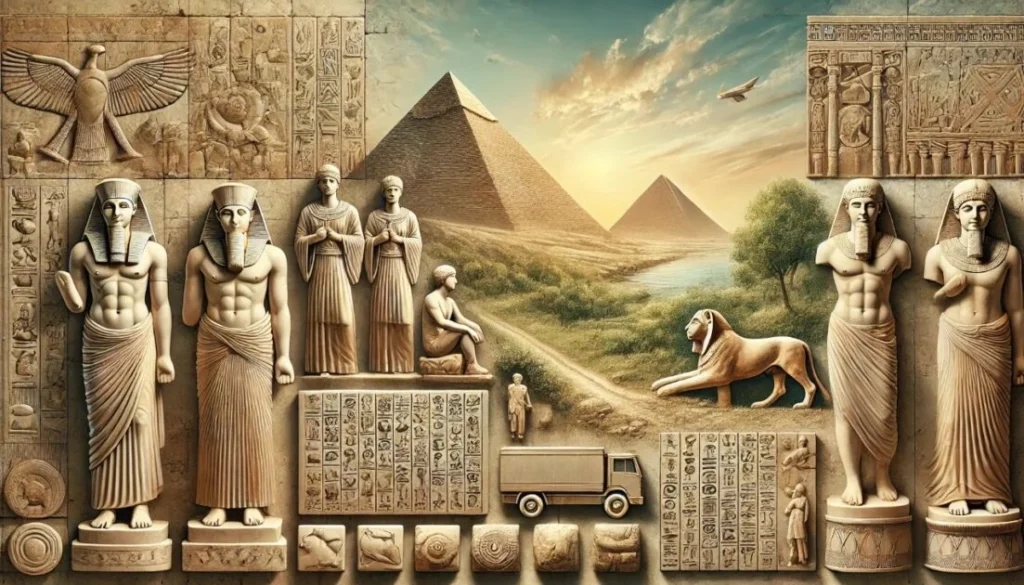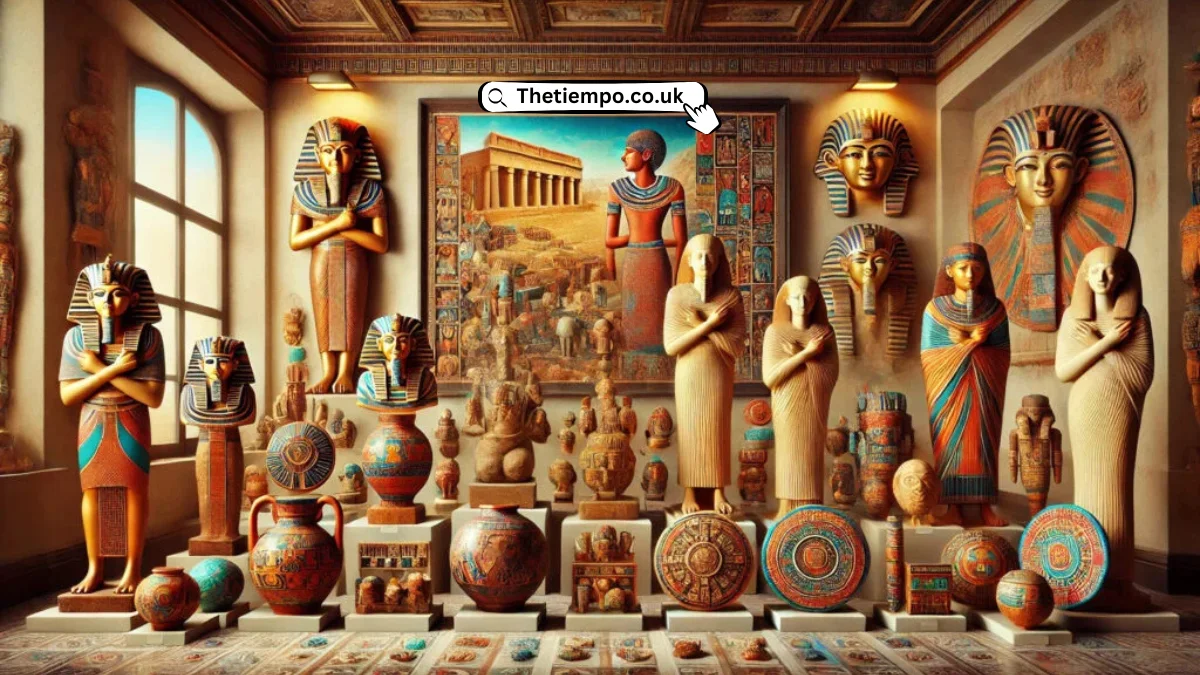Introduction
The realm of Ancient Artz is vast, encompassing various cultures, continents, and time periods. These artworks reflect the evolution of human creativity and the diverse ways early civilizations viewed the world around them. From the earliest cave paintings to sophisticated sculptures and grand architectural marvels, ancient art tells the story of human progress, societal values, and spiritual beliefs. This article delves into different forms of Ancient Artz, the origins of these artistic endeavors, and how they have influenced future generations, providing us with a deeper understanding of ancient civilizations.
Table of Contents
| Section | Description |
|---|---|
| Ancient Artz Origins | Overview of the beginnings of ancient art |
| Types of Ancient Artz | Examination of different Ancient Artz forms |
| Cultural Significance | The role of ancient art in early societies |
| Notable Examples of Ancient Art | Famous works and what they represent |
| Evolution and Influence | How ancient art influenced later civilizations |
| Conclusion | Summary and lasting impact of ancient artz |
Ancient Artz Origins
The Dawn of Artistic Expression
Artistic expression likely began as early humans sought ways to communicate ideas, share knowledge, and document their experiences. The first forms of ancient artz were often created out of necessity, but they evolved over time into symbols of beauty and power. By 30,000 BCE, early humans had begun creating cave paintings in France, Spain, and Indonesia, primarily depicting animals and scenes from daily life. The vibrant colors—derived from natural pigments—have allowed these paintings to endure through millennia, offering us a fascinating glimpse into early human creativity and lifestyles.
Rise of Civilized Art
With the rise of organized societies, art grew in complexity, scale, and purpose. Ancient Egypt, for example, developed a highly stylized form of art devoted to religious and royal purposes. Art was no longer merely a form of survival or documentation; it became a way to reinforce societal structures, cultural beliefs, and the divine authority of rulers. Similarly, the people of ancient Mesopotamia began creating cylinder seals, relief carvings, and monumental architecture that celebrated both gods and rulers, signifying the increasing importance of art in governance, religion, and daily life.
Types of Ancient Artz

Ancient art is diverse, varying widely in style, purpose, and medium, depending on the culture and materials available. Each form of art provides unique insights into the lives and beliefs of the people who created it. Here’s a closer look at some of the major types of ancient artz:
Sculpture and Statuary
One of the most enduring forms of Ancient Artz, sculpture served as an expression of power, devotion, and beauty. Ancient societies used sculpture to honor deities, commemorate rulers, and celebrate mythological heroes. Each civilization developed a unique style:
Egyptian Statues: Egyptian sculptures were often stylized and rigid, reflecting the pharaoh’s authority and timeless divinity. Monumental statues, like the iconic Sphinx of Giza, were created to embody both power and eternity, depicting the ruler as both human and god.
Greek Sculptures: Greek sculptures focused on realism and the human form, showcasing ideals of physical beauty, balance, and proportion. The Discobolus (Discus Thrower) and Venus de Milo are prime examples of Greek artists’ celebration of the human body and their pursuit of aesthetic perfection.
Architectural Art
Architecture in Ancient Artz civilizations was much more than functional; it was an art form representing technological progress, cultural beliefs, and political power.
Egyptian Pyramids: These monumental tombs, including the Great Pyramid of Giza, were built to house and protect the pharaohs in their journey to the afterlife. Their scale, precision, and symbolic structure continue to awe archaeologists and engineers alike.
Mayan Pyramids: The Mayan civilization constructed stepped pyramids such as those at Chichen Itza to honor their gods. These structures were often aligned with celestial events, reflecting the Mayans’ advanced understanding of astronomy and their religious devotion.
Pottery and Ceramics
Ancient pottery served both practical and decorative purposes and can tell us a great deal about a civilization’s trade, diet, and social customs.
Greek Pottery: Known for its black- and red-figure techniques, Greek pottery was often decorated with intricate scenes from mythology and daily life. The shapes of pots, from amphorae to kraters, served various purposes and were decorated with exceptional skill, reflecting both artistic and functional intentions.
Chinese Ceramics: Chinese pottery, especially during the Han and Tang dynasties, became famous for its meticulous craftsmanship and unique glazing techniques. Chinese ceramics set the standard for pottery worldwide, influencing art forms as far away as Europe.
Jewelry and Personal Adornments
In ancient times, jewelry was a marker of social status and wealth and often held spiritual or symbolic significance.
Egyptian Jewelry: Egyptians crafted elaborate jewelry from gold and gemstones. Pieces like scarab amulets were worn for protection, while others signified status, as seen in the tomb of Tutankhamun.
Roman Cameos and Rings: Romans popularized the use of carved gemstones, often used in rings or as cameos. These pieces were functional, serving as personal seals, while also being valuable status symbols.
Painting and Mural Art
Painting was a popular form of ancient artz, found on the walls of tombs, temples, and homes.
Frescoes of Pompeii: The preserved walls of Pompeii reveal frescoes depicting landscapes still lifes. And mythological scenes, giving us insights into the tastes and interests of wealthy Romans.
Egyptian Tomb Paintings: Egyptian tombs were adorned with symbolic depictions of the afterlife. These scenes depicted the deceased’s journey through the underworld, showing their interactions with gods and illustrating the Egyptians’ strong belief in the afterlife.
Cultural Significance of Ancient Artz

Art in ancient times served multiple roles in society, often deeply intertwined with religion, politics, and everyday life.
Art as a Religious Expression
In Ancient Artz civilizations, art was considered a powerful bridge to the divine. Egyptian tomb paintings, for instance, were believed to guide and protect the soul in the afterlife, often depicting scenes of the journey into eternity. In India, intricate temple carvings and sculptures depicted gods and goddesses, emphasizing the divine nature of the human experience. This spiritual dimension of ancient art provided comfort, guidance, and connection to the supernatural for those who observed it.
Art as a Symbol of Power and Authority
Ancient rulers used art as a means of asserting their power and divine right to rule. Monumental statues, murals, and architectural wonders served as visual reminders of the ruler’s strength, authority, and connection to the gods. The colossal statues of Egyptian pharaohs, the detailed busts of Roman emperors. And the grand temples of the Maya were symbols of their power and divine favor.
Notable Examples of Ancient Artz
Below is a table highlighting some of the most renowned examples of ancient art, their significance, and their cultural impact.
| Artwork | Civilization | Description |
|---|---|---|
| Cave Paintings of Lascaux | Prehistoric Europe | Animal and hunting scenes, using natural pigments and simple tools |
| Great Pyramids of Giza | Ancient Artz Egypt | Massive tomb structures built to honor and house pharaohs for eternity |
| Terracotta Army | Ancient China | Over 8,000 life-sized soldier statues guarding Emperor Qin Shi Huang’s tomb |
| Parthenon | Ancient Greece | A masterpiece of Greek architecture dedicated to Athena, symbolizing Athenian power |
| Sanchi Stupa | Ancient India | A Buddhist monument symbolizing enlightenment and the journey toward spiritual fulfillment |
| Mosaic of Alexander the Great | Ancient Artz Rome | A detailed mosaic showing Alexander’s military prowess, representing Rome’s admiration for Greek culture |
Evolution and Influence of Ancient Artz

The legacy of Ancient Artz has deeply influenced various later artistic movements and civilizations. Greek and Roman art, for instance, laid the groundwork for the aesthetics of the Renaissance. Artists such as Michelangelo and Leonardo da Vinci drew inspiration from the realism, symmetry. And proportions seen in ancient Greek statues. In Asia, the intricate designs of Chinese ceramics influenced pottery techniques across Asia and Europe, where “china” became a highly coveted art form.
Ancient Artz architectural styles also inspired the construction of neoclassical buildings. And motifs from ancient times are often revived in literature, sculpture, and visual arts. The techniques and themes introduced by ancient artists continue to shape. And inspire modern art, bridging the past and present in unique ways.
Conclusion
The legacy of Ancient Artz endures as a window into the values, beliefs, and aesthetics of early human civilizations. Ancient art offers us a profound connection to the past, helping us understand the evolution of cultural identity and creativity. From the meticulous stone carvings of the Maya to the grand architectural feats of the Romans. Ancient Artz remains a testament to the enduring creativity, resilience, and sophistication of human beings. Through these artistic expressions, we are reminded of our shared heritage. And the deep roots of artistic expression that continue to influence and inspire across generations.
FAQ’s
What is Ancient Artz?
Ancient Artz refers to the various forms of art created by early civilizations across the world, including paintings, sculptures, pottery, architecture, and jewelry. These works were often created for religious, social, and cultural purposes, reflecting the beliefs, values, and lifestyles of ancient societies.
What are some examples of Ancient Artz?
Notable examples include the Cave Paintings of Lascaux in France, the Great Pyramids of Giza in Egypt, the Terracotta Army in China, and the Parthenon in Greece. Each of these artworks reflects unique cultural practices and serves as a historical record of its civilization.
How was ancient art different from modern art?
Ancient art was often deeply connected to religion, politics, and daily life, focusing on themes of power, spirituality, and survival. Unlike modern art, which often emphasizes individual expression, ancient art served communal, ceremonial, and governmental purposes.
Why did ancient civilizations create art?
Art in ancient times was created for multiple purposes: as offerings to deities, to honor rulers, to document significant events, and to serve practical uses, such as in pottery. Art was also a way to communicate with the spiritual realm, convey social status, and celebrate life’s important events.
What materials did ancient artists use?
Ancient artists used natural materials available in their environment. These included stone, clay, metals like gold and bronze, natural pigments for paint, and animal bones and shells for tools. For example, Egyptian artists used limestone and gold, while Greek artists preferred marble and bronze.
How did ancient art influence later periods?
Ancient art greatly influenced later art periods, especially during the Renaissance, where Greek and Roman styles were revived. Architectural styles, realism in sculpture, and the use of proportion and symmetry from ancient art continue to shape modern art and architecture.
